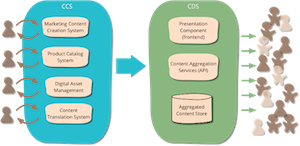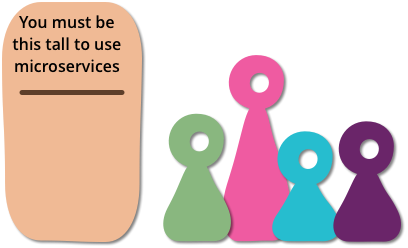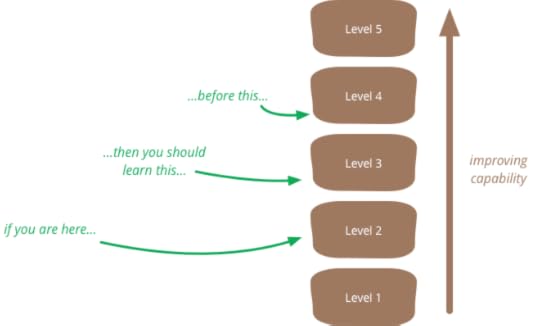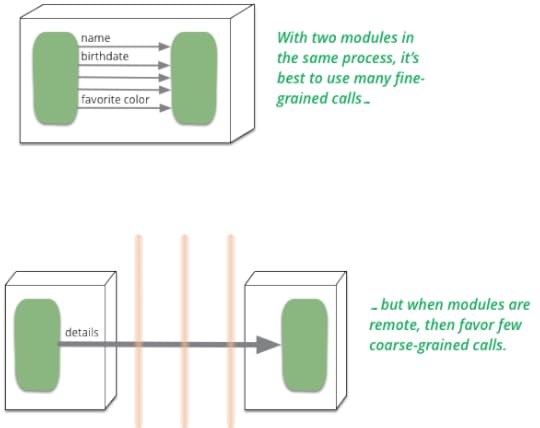Martin Fowler's Blog, page 38
October 6, 2014
Building a two-stack CMS

Our Pune office recently did a project with a large manufacturer to build its global marketing website. The site involved complex content, lots of traffic (two million page views a day), localization to nearly a hundred locales, and high availability. In this infodeck my colleague Sunit Parekh and I dig into a key feature of the system - taking on the principle of Editing-Publishing Separation by building a two-stack architecture. This allowed the client to continue to use a wide range of software for their complex content editing needs, but at the same time providing a content delivery platform that supported a global site with high traffic and availability.
September 8, 2014
photostream 74
September 5, 2014
Setting up a ruby development VM with Vagrant, Chef, and rbenv
Some notes from my experiences in setting up a Vagrant VM to help collaborators use my web publishing toolchain. I used Chef to provision the VM and rbenv to install and control the right version of ruby.
August 31, 2014
Restoring a deleted note in Apple's notes app
I recently deleted a note on my Notes app on my apple laptop. As someone who is a paranoid keeper of backups, and usually commits all my work to a repository like git, I don’t worry much about accidental deletion. But Apple’s notes app doesn’t have any form of version control, and it’s all too easy to delete something by accident. I have a daily rsync backup and run time machine, but googling couldn’t uncover a simple way of getting the note back. So in case someone else needs to do this, here’s what I did.
August 30, 2014
photostream 73
August 29, 2014
Bliki: MicroservicePrerequisites
As I talk to people about using a microservices architectural
style I hear a lot of optimism. Developers enjoy working with
smaller units and have expectations of better modularity than with
monoliths. But as with any architectural decision there are
trade-offs. In particular with microservices there are serious
consequences for operations, who now have to handle an ecosystem of
small services rather than a single, well-defined monolith.
Consequently if you don't have certain baseline competencies, you
shouldn't consider using the microservice style.

Rapid provisioning: you should be able to fire up a new server in
a matter of hours. Naturally this fits in with
CloudComputing, but it's also something that can be done
without a full cloud service. To be able to do such rapid
provisioning, you'll need a lot of automation - it may not have to
be fully automated to start with, but to do serious microservices
later it will need to get that way.
Basic Monitoring: with many loosely-coupled services
collaborating in production, things are bound to go wrong in ways
that are difficult to detect in test environments. As a result it's
essential that a monitoring regime is in place to detect serious
problems quickly. The baseline here is detecting technical issues
(counting errors, service availability, etc) but it's also worth
monitoring business issues (such as detecting a drop in orders). If
a sudden problem appears then you need to ensure you can quickly
rollback, hence…
Rapid application deployment: with many services to mangage, you
need to be able to quickly deploy them, both to test environments
and to production. Usually this will involve a
DeploymentPipeline that can execute in no more than a
couple of hours. Some manual intervention is alright in the early
stages, but you'll be looking to fully automate it soon.
These capabilities imply an important organizational shift -
close collaboration between developers and operations: the DevOps
culture. This collaboration is needed to ensure that provisioning
and deployment can be done rapidly, it's also important to ensure
you can react quickly when your monitoring indicates a problem. In
particular any incident management needs to involve the development
team and operations, both in fixing the immediate problem and the
root-cause analysis to ensure the underlying problems are fixed.
With this kind of setup in place, you're ready for a first system
using a handful of microservices. Deploy this system and use it in
production, expect to learn a lot about keeping it healthy and
ensuring the devops collaboration is working well. Give yourself
time to do this, learn from it, and grow more capability
before you ramp up your number of services.
If you don't have these capabilities now, you should ensure you
develop them so they are ready by the time you put a microservice
system into production. Indeed these are capabilities that you
really ought to have for monolithic systems too. While they aren't universally
present across software organizations, there are very few
places where they shouldn't be a high priority.
Going beyond a handful of services requires more. You'll need to
trace business transactions though multiple services and
automate your provisioning and deployment by fully embracing
ContinuousDelivery. There's also the shift to product
centered teams that needs to be started. You'll need to organize
your development environment so developers can easily swap between
multiple repositories, libraries, and languages. Some of my contacts are
sensing that there could be a useful MaturityModel here that can
help organizations as they take on more microservice implementations -
we should see more conversation on that in the next few years.
Acknowledgements
This list originated in discussions with my ThoughtWorks
colleagues, particularly those who attended the microservice
summit earlier this year. I then structured and finalized the
list in discussion with Evan Bottcher, Thiyagu Palanisamy, Sam
Newman, and James Lewis.
And as usual there were valuable
comments from our internal mailing list from Chris Ford, Keif
Morris, Premanand Chandrasekaran, Rebecca Parsons, Sarah
Taraporewalla, and Ian Cartwright.
August 27, 2014
Retreaded: CourtesyImplementation
Retread of post orginally made on 12 Aug 2004
When you a write a class, you mostly strive to ensure that the
features of that class make sense for that class. But there are
occasions when it makes sense to add a feature to allow a class to
conform to a richer interface that it naturally should.
The most common and obvious example of this is one that comes up
when you use the composite pattern. Let's consider a simple example
of containers. You have boxes which can contain other boxes and
elephants (that's an advantage of virtual elephants.) You want
to know how many elephants are in a box, considering that you need
to count the elephants inside boxes inside boxes inside the box. The
solution, of course, is a simple recursion.
# Ruby
class Node
end
class Box < Node
def initialize
@children = []
end
def << aNode
@children << aNode
end
def num_elephants
result = 0
@children.each do |c|
if c.kind_of? Elephant
result += 1
else
result += c.num_elephants
end
end
return result
end
end
class Elephant < Node
end
Now the kind_of? test in num_elephants is a smell, since we
should be wary of any conditional that tests the type of an
object. On the other hand is there an alternative? After all we are
making the test because elephants can't contain boxes or elephants, so it doesn't
make sense to ask them how many elephants are inside them. It
doesn't fit our model of the world to ask elephants how many
elephants they contain because they can't contain any. We might say
it doesn't model the real world, but my example feels a touch too
whimsical for that argument.
However when people use the composite pattern they often do
provide a method to avoid the conditional - in other words they do
this.
class Node
#if this is a strongly typed language I define an abstract
#num_elephants here
end
class Box < Node
def initialize
@children = []
end
def << aNode
@children << aNode
end
def num_elephants
result = 0
@children.each do |c|
result += c.num_elephants
end
return result
end
end
class Elephant < Node
def num_elephants
return 1
end
end
Many people get very disturbed by this kind of thing, but it does
a great deal to simplify the logic of code that sweeps through the
composite structure. I think of it as getting the leaf class
(elephant) to provide a simple implementation as a courtesy to its
role as a node in the hierarchy.
The analogy I like to draw is the definition of raising a number
to the power of 0 in mathematics. The definition is that any number
raised to the power of 0 is 1. But intuitively I don't think it
makes sense to say that any number multiplied by itself 0 times is
1 - why not zero? But the definition makes all the mathematics work
out nicely - so we suspend our disbelief and follow the definition.
Whenever we build a model we are designing a model to suit how we
want to perceive the world. Courtesy Implementations are worthwhile
if they simplify our model.
reposted on 27 Aug 2014
August 26, 2014
Bliki: MaturityModel
A maturity model is a tool that helps people assess the current
effectiveness of a person or group and supports figuring out what
capabilities they need to acquire next in order to improve their
performance. In many circles maturity models have gained a bad
reputation, but although they can easily be misused, in proper hands
they can be helpful.
Maturity models are structured as a series of levels of
effectiveness. It's assumed that anyone in the field will pass
through the levels in sequence as they become more capable.
So a whimsical example might be that of mixology (a fancy term
for someone who makes cocktails). We might define levels like
this:
Knows how to make a dozen basic drinks (eg "make me a Manhattan")
Knows at least 100 recipes, can substitute ingredients (eg
"make me a Vieux Carre in a bar that lacks Peychaud's")
Able to come up with cocktails (either invented or recalled)
with a few simple constraints on ingredients and styles (eg
"make me something with sherry and tequila that's moderately sweet").
Working with a maturity model begins with assessment, determining
which level the subject is currently performing in. Once you've
carried out an assessment to determine your level, then you use the
level above your own to prioritize what capabilities you need to
learn next. This prioritization of learning is really the big
benefit of using a maturity model. It's founded on the notion that
if you are at level 2 in something, it's much more important to
learn the things at level 3 than level 4. The model thus acts as
guide to what to learn, putting some structure on what otherwise
would be a more complex process.

The vital point here is that the true outcome of a maturity model
assessment isn't what level you are but the list of things you need
to work on to improve. Your current level is merely a piece of
intermediate work in order to determine that list of skills to
acquire next.
Any maturity model, like any model, is a simplification: wrong
but hopefully useful. Sometimes even a crude model can help you
figure out what the next step is to take, but if your needed mix of
capabilities varies too much in different contexts, then this form
of simplification isn't likely to be worthwhile.
A maturity model may have only a single dimension, or may have
multiple dimensions. In this way you might be level 2 in 19th
century cocktails but level 3 in tiki drinks. Adding dimensions
makes the model more nuanced, but also makes it more complex - and
much of the value of a model comes from simplification, even if it's
a bit of an over-simplification.
As well as using a maturity model for prioritizing learning, it
can also be helpful in the investment decisions involved. A maturity
model can contain generalized estimates of progress, such as "to get
from level 4 to 5 usually takes around 6 months and a 25%
productivity reduction". Such estimates are, of course, as crude as
the model, and like any estimation you should only use it when you have a
clear PurposeOfEstimation. Timing estimates can also be
helpful in dealing with impatience, particularly with level changes
that take many months. The model can help structure such
generalizations by being applied to past work ("we've done 7 level
2-3 shifts and they took 3-7 months").
Most people I know in the software world treat maturity models
with an inherent feeling of disdain, most of which you can understand
by looking at the Capability
Maturity Model (CMM) - the best known maturity
model in the software world. The disdain for the CMM sprung from two
main roots. The first problem was the CMM was very much associated
with a document-heavy, plan-driven culture which was very much in
opposition to the agile software community.
But the more serious problem with the CMM was the corruption of
its core value by certification. Software development companies
realized that they could gain a competitive advantage by having
themselves certified at a higher level than their competitors - this
led to a whole world of often-bogus certification levels,
levels that lacked a CertificationCompetenceCorrelation. Using a
maturity model to say one group is better than another is a classic
example of ruining an informational metric by incentivizing it. My
feeling that anyone doing an assessment should never publicize the
current level outside of the group they are working with.
It may be that this tendency to compare levels to judge worth is a
fundamentally destructive feature of a maturity model, one that will
always undermine any positive value that comes from it. Certainly it
feels too easy to see maturity models as catnip for consultants
looking to sell performance improvement efforts - which is why
there's always lots of pushback on our internal mailing list whenever
someone suggests a maturity model to add some structure to our
consulting work.
In an email discussion over a draft of this article, Jason Yip
observed a more fundamental problem with maturity models:
"One of my
main annoyances with most maturity models is not so much that
they're simplified and linear, but more that they're suggesting a
poor learning order, usually reflecting what's easier to what's
harder rather than you should typically learn following this
path, which may start with some difficult things.
In other words,
the maturity model conflates level of effectiveness with
learning path"
Jason's observation doesn't mean maturity models are never a good
idea, but they do raise extra questions when assessing their
fitness. Whenever you use any kind of model to understand a
situation and draw inferences, you need to first ensure that the
model is a good fit to the circumstances. If the model doesn't fit,
that doesn't mean it's a bad model, but it does mean it's
inappropriate for this situation. Too often, people don't put enough
care in evaluating the fitness of a model for a situation before
they leap to using it.
Acknowledgements
Jeff Xiong reminded me that a model can be helpful for investment
decisions. Sriram Narayan and Jason Yip contributed some helpful feedback.
August 23, 2014
photostream 72
August 14, 2014
Microservices and the First Law of Distributed Objects

When I wrote Patterns of Enterprise Application Architecture, I
coined what I called the First Law of Distributed Object Design:
“don’t distribute your objects”. In recent months there’s been a lot
of interest in microservices, which has led a few people to ask
whether microservices are in contravention to this law, and if so
why I am in favor of them?
Martin Fowler's Blog
- Martin Fowler's profile
- 1103 followers






